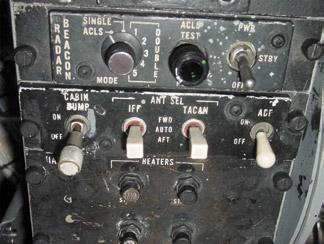3 minute read
Good To Be a Curious George
Next Article
Inspecting the wire bundles that connect to the engine-control panel, we found a wire chafing on a connector. All it took was a simple fix, and the aircraft again was up.
A few days passed, and that discrepancy was long behind us…or so I thought. At the beginning of our shift one day, we got a call that DCAG was flying around the boat because the fuel dump was inop on aircraft 603— the “hangar queen” we had robbed to get the replacement panel.
When that aircraft returned, we were hot on it, reading out wires. We quickly figured out that the fuel-dump valve wasn’t getting power. The wires went straight to the switch, which was on the engine-control panel, so that’s where we looked next. After removing the panel, the problem was obvious: A terminal had broken off the back of the fuel-dump switch. That panel was the same
My shop received a call from the materialcontrol work center for a part pickup. An antenna-select box ordered the night before had come in. When I opened up the container to do a receipt inspection, I noticed the panel also had a switch marked “cabin dump.” That label piqued my curiosity.
Thinking I may have picked up a part for the AME work center, I took the part to maintenance control to clarify the situation. They determined the panel had been ordered against a TACAN gripe on an “up” MAF.
A closer investigation revealed that this panel had the TACAN and IFF antenna-select switches, but it also had the cabin dump switch, making it a downing discrepancy when the box was pulled out of an held with the avionics, egress and maintenance-control maintainers to see. one we had borrowed a few days before. The evidence of faulty maintenance was staring me in the face. We fixed the gripe this time.
Although I had inspected the installed panel for integrity, I was not there during the installation process; therefore, I did not see the condition of the wires before the panel went in.
My oversight and lack of supervision did not cause a mishap, damage material, or injure anyone, but I had screwed up. I was lucky the worst thing was DCAG had to fly longer than planned. The broken wire easily could have been part of an important emergency system. This event has taught me that, as a supervisor and a CDI, I have to be more proactive in all maintenance actions done under my direction. Spot checks and in-process reviews can improve maintenance practices.
By AT3 Michael Jacildo
aircraft—this one had been taken out of aircraft 502. Maintenance control changed the MAF to a “down” discrepancy, and the jet did not go flying. Training was Knowing whether a removed panel is an up or down gripe is critical to aircraft safety. work centers. We were a bit lucky to catch this problem before
Miscommunication and lack of attention to detail it was too late. Lack of communication, inattention to resulted in the part being ordered improperly with a detail, and complacency are common factors in most PROJ PRI (project-priority code) of AK7, indicating the mishaps. We had several “holes in the cheese” lined up aircraft was partial mission capable. It should have been but found the problem in time. It really is necessary to ordered as AK0—not-mission capable. That simple train maintainers correctly and do by-the-book maintecoding would have made the gripe a “downer,” and it nance to prevent these types of situations. would have been flagged in the ADB for aircrew and Petty Officer Jacildo works in the AT shop at VAQ-131. Petty Officer Herbert works in the AE shop at VAW-123.




